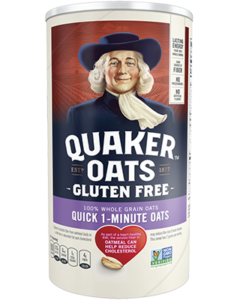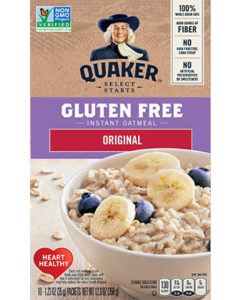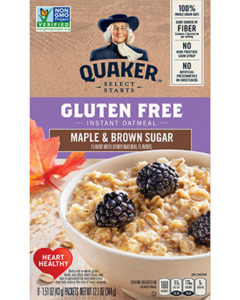The National Health and Nutrition Examination Survey from 2009-2010 among the U.S. that consumption of oatmeal nearly 20% by adults. these days oats consumption around the world enhanced dramatically, due to easy preparation method & nutritional value.
Oatmeal becomes plenty of fibers that has digestive benefits. But, if you have gluten sensitivity or have celiac disease, you will care regarding oats processing method and are they gluten-free?In these articles, we also detailed – are quaker oats gluten free? However, the safety of oats consumption and health benefits of oatmeal is important before knowing about gluten-free oats.
What is Oatmeal?
Oatmeal is made of hulled oat grains – groats – that either steel-cut, milled (ground) or rolled. Ground oats are also called “white oats”. Steel-cut oats are called “coarse oatmeal” or “Irish oatmeal” or “pinhead oats”. Rolled oats are often either thick or skinny, and perhaps “old-fashioned”, or “quick”, or “instant”. The term “oatmeal” is also employed in the U.S. and some parts of Canada as another word for an oat-based dish popular in such countries made up of either ground, steel-cut, or rolled oats. Oats are naturally gluten-free, they’ll come in contact with gluten-containing grains like wheat, rye, and barley at the farm, in storage or while transportation.When cooked, oatmeal usually has a subtle, sweet flavor and a creamy, typically chewy, texture. It’s sometimes served warm straight from the cooking pan, however, oats that are soaked overnight are usually eaten at room temperature.
Oats have been cultivated as early as a 1000 B.C. by the Greeks and Romans, that primarily harvested for animal feed. While oats are a staple form of nourishment in Scotland for hundreds of years, oatmeal’s presence as a mainstream food is relatively recent. The Quaker Oats Company helped propel oatmeal’s popularity within the U.S. by pioneering faster-cooking varieties like oatmeal in the late 1800s, and instant oats in 1966.
Both types of rolled oats may be eaten uncooked(Muesli), that may be mixed with milk, almond milk, soy milk, other plant milk, yogurt, or fruit juice. It also cooked with water or milk to make porridge. In some countries, rolled oats are eaten raw with milk and sugar, generally added with raisins.
Porridge is served in many ways. Some of the Western countries, porridge is served with milk or cream and a sweetener, such as refined sugar. The term “oatmeal” typically refers to porridge made up of the bran or fibrous husk likewise as the oat kernel or groat. Rolled oats are used as a key ingredient in granola breakfast cereals (toasted oats are blended with sugar and/or nuts and raisins) and granola bars.
Rolled oats also used as an ingredient in oatmeal cookies, British flapjack bars, oatcakes, and baked oatmeal dessert dishes such as Apple Brown Betty and apple crisp. Oats also be added to foods as an accent, as in the topping on many oat bran loaves of bread and as the coating on Caboc cheese. Oatmeal also used as a thickening agent in thick, savory Arabic or Egyptian meat-and-vegetable soups, and sometimes as a way of adding relatively low-cost fiber and nutritional content to meatloaf.
Nutrition of Oatmeal
Oatmeal, cooked by boiling or microwave, is 84% water and contains 12% carbohydrates, including 2% dietary fiber, and 2% of protein and fat. In a 100 gram amount of oatmeal, cooked oatmeal provides 71 Calories and contains 29% of the Daily Value for manganese and moderate content of phosphorus and zinc nearly 11% Daily Value each, with no other micronutrients insignificant content.Oats are loaded with vital vitamins, minerals, and antioxidant. Half cup (78 grams) of dry oats comprise-
- Vitamin B1: 39% of the RDI
- Vitamin B5: 10% of the RDI
- Smaller amounts of calcium, potassium, vitamin B6 and vitamin B3.
- Phosphorus: 41% of the RDI
- Manganese: 191% of the RDI
- Magnesium: 34% of the RDI
- Iron: 20% of the RDI
- Copper: 24% of the RDI
- Folate: 11% of the RDI
- Zinc: 20% of the RDI
- Dietary reference intakes ( DRI )
This means that oats are among the foremost nutrient-dense foods you’ll be able to eat.
Health Benefits of Oatmeal
Oatmeal and other oat products were the subjects of a 1997 ruling by the FDA that consuming oat bran or whole rolled oats can reduce the risk of heart disease when combined with a low-fat diet via the effect of oat beta-glucan to lowering blood cholesterol level. A similar conclusion was reached in 2010 by the EU Food Safety Authority.Oats are the healthiest grains on earth. The gluten-free whole grain and a great source of important vitamins, fiber, minerals, and antioxidants. Research shows that oats and oatmeal have several health benefits. These include lower blood sugar levels, weight loss, and lowering the risk of heart disease.
Oats contain beta-glucan, a type of soluble fiber. Beta-glucan partly dissolves in water and forms a thick, gel-like solution within the gut. The health benefits of beta-glucan fiber-
- Lowering blood sugar and insulin response.
- Lowering LDL and total cholesterol levels.
- Increased growth of good bacteria within the GI tract.
- Increased feeling of fullness.
1. Enhance Cardiac Health
Antioxidants present in oats that are beneficial for heart disease. Oats contain a fiber called beta-glucan that helps lower cholesterol levels. Beta-glucan is the soluble fiber in oats, and it reduces bad cholesterol(LDL)without affecting the levels of good cholesterol(HDL).Oat bran further contains vitamin E, that is nutrient for heart health. According to the Australian study, oat fiber is more efficient in lowering bad cholesterol levels than the wheat fiber.
The Australian study also indicates that oatmeal or bran can indeed reduce the risk of cardiovascular disease. Oat bran assists by blocking the absorption of those substances in the gut that can contribute to preventing heart disease.
According to Harvard Medical School, oats are the best form of whole grains to lower bad cholesterol levels. And include more whole grain oats add in your diet, you can try the steel-cut Oats. Report by the University of Wisconsin Madison, beta-glucan in the oats, acts as a heart-healthy chemical.
2.Roll in Controls Blood Sugar Levels
Oats are low glycemic index food, and high fiber content in oats helps to regulate blood sugar levels and reduce the risk of type-2 diabetes. Also, high fiber and complex carbohydrates in oats, are digested slowly. All kinds of oats are not good for your health. Stay away from instant or flavored types oats, which are loaded with sugar.3. Roll to Treat Hypertension
Consuming oats reduce blood pressure. For this reason, you can choose non-instant and organic oatmeal. The beta-glucan in the play a beneficial roll on carbohydrate metabolism and blood pressure levels in obese people. Oatmeal also reduces the levels of stress hormones and boosts serotonin, that induces a feeling of calmness. All of this contributes to low blood pressure.4. Improve Immunity
Oatmeal contains unique fiber known as beta-glucan that can enhance your immunity levels. Oats are rich in selenium and zinc that play a vital role in fighting infections.Beta-glucan also improves immunity in individuals, who suffer from chronic fatigue syndrome or physical or emotional stress. They improve immune levels during treatments such as chemotherapy or radiation.
5.Eliminate Cancer Risk
Oats fully loaded with fiber that prevents rectal and colon cancers. According to the American Cancer Society-Lignan, that found in oats helps to prevent cardiovascular disease and reduce the risk of hormone-related cancers like prostate, breast and ovarian cancer. For this reason, oats are good for individuals.6. Improve Sleep Quality
Amino acids and other nutrients found in oats help to produce melatonin, that induces sleep. When oats mixed with milk or honey, become a wonderful bedtime snack. Whole grain oats promote insulin production, which can assist the neural pathways to receive tryptophan. An amino acid contains tryptophan that serves as a sedative to the brain. Oats are rich in vitamin B6, which helps to eliminate your stress and promote sleep.7. Skin Care
Oats often found in various skin care products. Makers of those products typically list finely ground oats as “colloidal oatmeal.”The Food and Drug Administration approved colloidal oatmeal as a skin-protective substance back in 2003. But in fact, oats have a long history of use in the treatment of itch and irritation in various skin conditions. Oat-based skin products could improve uncomfortable symptoms of eczema.
8. Relieve Constipation
People often experience constipation, irregular bowel movements that are difficult to pass. Laxatives are frequently used to relieve constipation. However, they’re also associated with weight loss and reduced quality of life. Research indicates that oat bran, the fiber-rich outer layer of the grain, may support relieve constipation.Are Quaker Oats Gluten Free
While oats are naturally gluten-free, they may come in contact with gluten-containing grains such as wheat, rye, and barley at the farm, in storage or during transportation. Quaker has launched gluten-free instant oatmeal that uses mechanically processed oats. As the world’s leader in oat milling for 140 years, our team of experts developed a breakthrough cleaning system to remove these stray grains so that we can deliver gluten-free oatmeal consumers can trust. Mechanically processed oats are debatable in the gluten-free community.
Prior to passage of the Food and Drug Administration gluten-free labeling rules solely oats specially grown and processed to be gluten free were allowed in the product with a gluten-free label. But the Food and Drug Administration doesn’t require the use of those “pure oats” and permits the use of oats in a product labeled gluten-free.
The gluten-free living will offer a lot of details regarding Quaker oatmeal as they become available.
Some specifics on the process for making Quaker Gluten Free Oatmeal:
- Our breakthrough mechanical and optical sorting system sharply seeks out and removes gluten-containing grains based on length, density, and color a fanatical cleaning house for gluten-free products.
- We have a tendency to implement testing protocols across a range of checkpoints throughout the milling process to verify our high-quality oats meet Food and Drug Administration standards whereas maintaining Quaker’s standards for quality, taste, and texture.
- Throughout the milling process, dedicated cutting and employed flaking instrumentality.
- Any ingredients while added throughout packaging are gluten-free.
- The packaging line is completely cleaned and prevent any cross-contamination.
- Once prepackaged, there’s an additional review checkpoint on samples from every production run to confirm they meet Food and Drug Administration and Quaker standards for gluten-free.
Feature Of Quaker Gluten Free Oatmeal
- Is heart-healthy and made with 100% whole grain Quaker Oats.
- Is a smart source of fiber and different essential vitamins and minerals.
- Offers the same nice taste and nutrition of our traditional oatmeal.
- On Quaker Oats web site the company declared following 3 varieties of oats are gluten-free-
1.QUAKER® GLUTEN FREE QUICK 1-MINUTE OATS
Per Serving Contains Calories 150
Quaker® Gluten Free Quick 1-Minute Oats, our skilled milling techniques take away stray gluten-containing grains to deliver gluten-free oats with an equivalent authentic toasted flavor you’ve come to like.
2.QUAKER® GLUTEN FREE INSTANT OATMEAL ORIGINAL
Per Serving Contains Calories 13o
Quaker® Gluten Free Instant Oatmeal provides you all the complete flavor with the reassurance of gluten-free oats.
3.QUAKER® GLUTEN FREE INSTANT OATMEAL-MAPLE & BROWN SUGAR FLAVOR
Per Serving Contains Calories 160
The sweet tastes of maple and brown sugar Quaker® Gluten Free Instant Oatmeal come together with the reassurance of gluten-free oats during this warm and delicious bowl of goodness.
Are Quaker Oats Safe to Eat
The Environmental Working Group (EWG), a nonprofit organization, that exposed traces of glyphosate in several sorts of granola, oat cereal, oatmeal, and snack bars. nearly three-quarters of food samples showed higher glyphosate levels.
In 2015, the International Agency for analysis on Cancer classified- glyphosate joined to non-Hodgkin’s cancer.
In 2016, the Food and Drug Administration proclaimed that it would begin testing for glyphosate in four widely used crops: soybeans, corn, milk, and eggs.
On the web site of Quaker Oats, the company declared that it doesn’t add glyphosate throughout any a part of the milling process. However, it’s commonly used by farmers who apply in pre-harvest stages. The faq page of the web site states, “Once the oats are transported to us,” “we put them through our rigorous process that thoroughly cleanses them. If any levels of glyphosate which will stay are trace amounts and considerably below any limits that are set by the Environmental Protection Agency (EPA) as safe for human consumption. For this reason, you can take quacker oats without and any doubt and it’s safe to eat.















0 comments:
Post a Comment